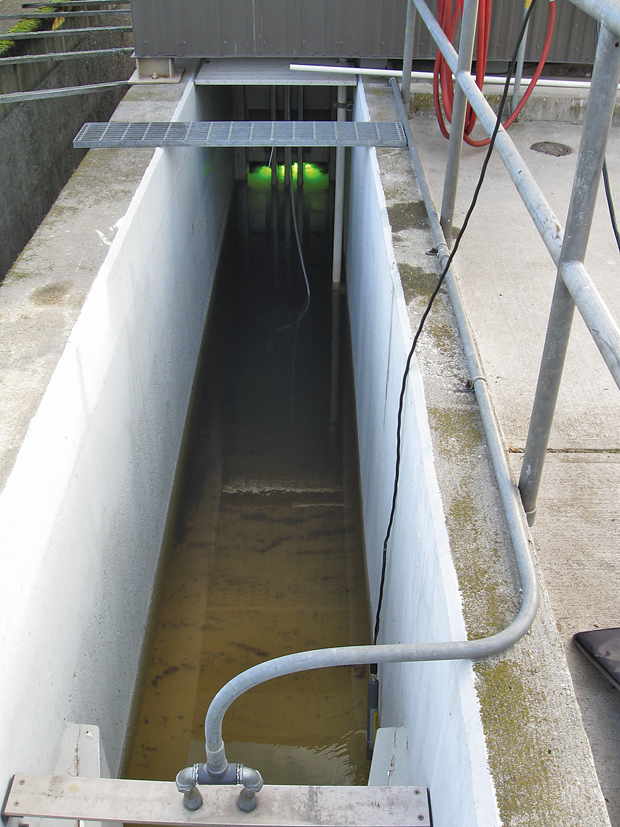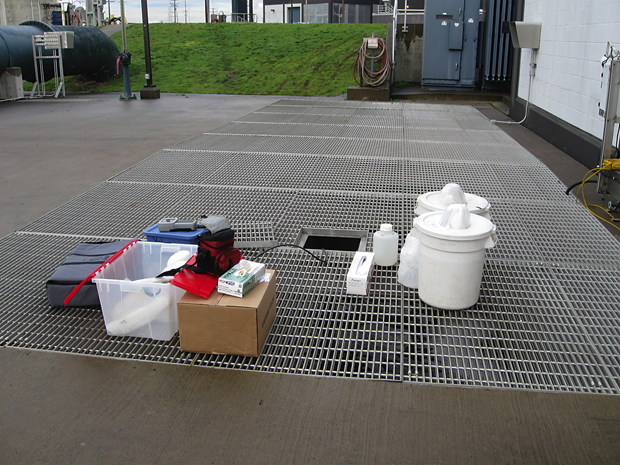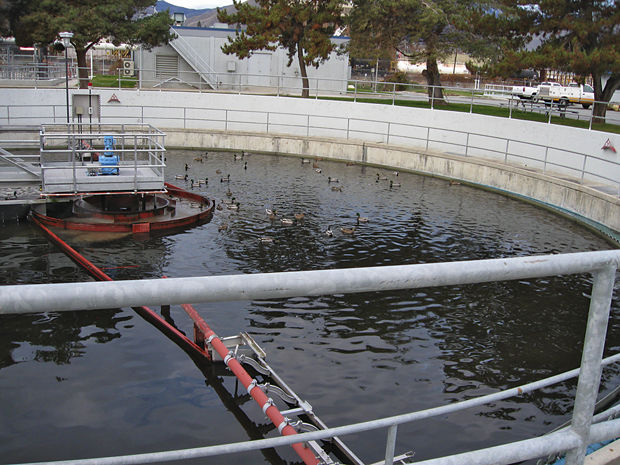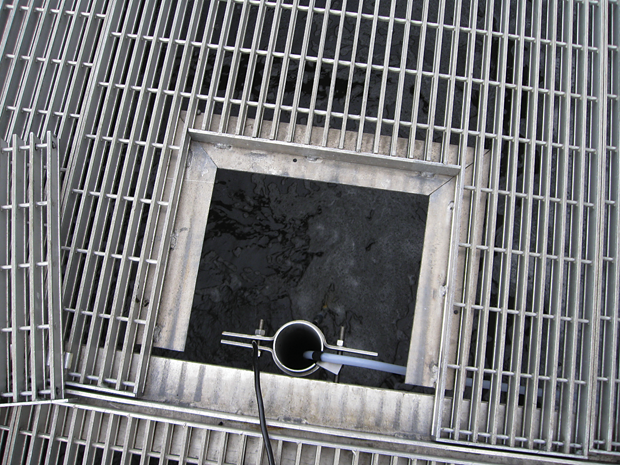Scientific Investigations Report 2012–5068
Contaminant Concentrations in Wastewater-Treatment-Plant EffluentAnthropogenic Organic CompoundsAnthropogenic organic compounds were measured at each WWTP (table 9), but an obvious pattern based on population (table 1) did not emerge from the results. For instance, it might be expected that a larger number of compounds may be detected at larger population centers with a smaller number of detections occurring at smaller population centers. If this were true, large differences may be expected between the results for Umatilla (roughly 5,000 people) and for Portland (roughly 500,000 people), but this is not often the case. The data indicate that there are many more variables (for instance treatment technology) affecting the presence and concentration patterns than simply population. Flame retardants and steroids were consistently detected in all WWTP‑effluent samples, although few pesticides or PAHs were detected, except at Longview. Longview also was notable because it had the greatest number of detections and the concentrations were usually among the highest, particularly for the personal-care-product compounds. The compounds at all WWTPs (table 9) were two flame retardants [tri(2chloroethyl)] phosphate and tri(dichloroisopropyl)phosphate), a fixative often included in sunscreen (benzophenone), a suspected endocrine disruptor used as a fumigant (1,4-dichlorobenzene), an extensively used musk (galaxolide), two fecal indicators (cholesterol and 3-beta-coprostanol), and a plant sterol (beta-sitosterol). Compounds also found in all samples except those collected in Umatilla included a known endocrine disrupter and detergent metabolite (NP2EO), another flame retardant (tributyl phosphate), another extensively used musk (tonalide), a common ingredient in cosmetics and pharmaceuticals (triethyl citrate), and a plasticizer (triphenyl phosphate). The effluent from all cities except Richland contained a popular stimulant (caffeine) and a suspected endocrine disruptor and disinfectant used in most hand soaps (triclosan). These examples show the variety and prevalence of these compounds in WWTP effluent. 
Effluent stream past ultraviolet disinfection at the City of Hood River Wastewater-Treatment Plant, Oregon, December 2008. Many of these compounds are somewhat hydrophobic, indicating that they prefer to be associated with sediment or solids rather than the water phase. Observing the amount of these compounds transported in the unfiltered effluent raises questions about what types of compounds may be detected in the biosolids generated by the WWTPs, and at what concentrations. Kinney and others (2006) surveyed biosolids destined for land application from 9 cities across the United States and detected 25 AOCs present. All of these compounds also were found in this study, except fluoxetine, which was not measured, indicating that biosolids may be a source of contamination that can be studied in the future in the Columbia River Basin (Oregon Department of Environmental Quality, 2011). PharmaceuticalsPharmaceuticals are expected to be in WWTP effluent because of the amount that passes through the body. In filtered effluent samples, 14 human-health pharmaceuticals were analyzed for and all but albuterol and warfarin were detected from at least one city (table 10). Two pharmaceuticals were detected in samples collected at all WWTPs—carbamazepine, a prescription drug used to treat epilepsy, bipolar disorder, and attention deficit hyperactivity disorder; and diphenhydramine, a common ingredient in over-the-counter medicines used for allergy relief or as a sleep aid, although trimethoprim, a prescription antibiotic, was detected at all WWTPs except Umatilla. A few studies have determined that the wastewater‑treatment process removes or degrades less than 20 percent of the carbamazepine entering the plant (Heberer, 2002; Rounds and others, 2009). Therefore, it is not surprising that carbamazepine was the most frequently detected pharmaceutical in this study, the Chesapeake Bay (Pait and others, 2006), Las Vegas Wash (Boyd and Furlong, 2002), and streams in Germany (Ternes, 1998). Little work has been done to assess toxicity of carbamazepine in the aquatic environment, but one study showed that acute toxicity for bacteria, algae, diatoms, and crustaceans was at the milligrams per liter level (Ferrari and others, 2004), much higher than the concentrations reported here. Diphenhydramine and trimethoprim have been reported in the Columbia River Basin in trace amounts in both the water column and bed sediments (Morace, 2006; Nilsen and others, 2007). It is difficult to determine potential aquatic effects of diphenhydramine because of its multiple modes of action on histamines, acetylcholine, and transporter receptors (Berninger and others, 2011). When tested on the aquatic invertebrate Daphnia magma, Berninger and others (2011) found a no-observed-effect level at the environmentally relevant concentration of 0.8 µg/L, eight times higher than the highest concentration measured in this study. The highest detection frequency of any antibiotics was for trimethoprim in a study of streams in the United States (Kolpin and others, 2002), and was detected in approximately 90 percent of WWTP-effluent samples and 20 percent of stream samples in a German study (Hirsch and others, 1999). Lindberg and others (2007) determined that a trimethoprim concentration of 16 mg/L in water caused growth inhibition in 50 percent of a test species of green algae. Lam and others (2004) calculated trimethoprim to have a half-life of 5.7 days. 
Sampling effluent at the Vancouver Westside Wastewater-Treatment Plant, Washington, December 2008. EstrogenicitySamples collected from WWTPs in 2008 were screened for total estrogenicity of the compounds in the sample using YES (David Alvarez, U.S. Geological Survey, written commun., November 6, 2009). EEQ values are intended to measure the potential biological effects of the mixtureof chemicals present in the sample, and therefore, are not compared to individual compounds in this report. The compounds that make up these complex mixtures likely have not all been measured in this study. Likewise, the interactions of these compounds in terms of synergistic or antagonistic effects are not defined well enough to analyze relationships between the EEQ and a list of compounds. A large suite of natural and synthetic hormones and phytoestrogens that may be available in the environment could affect the EEQ. Manmade chemicals like phthalates, alkylphenol surfactants, and potentially musks or fragrances also may have estrogenicity that could contribute to the EEQ measure. For all of these reasons, the EEQs measured for this study are not related to compound concentrations, but are used to indicate a measure of the potential for biological effects in the ecosystem. For this study, the unfiltered WWTP-effluent samples sent to CERC were filtered and the YES was performed on both the filtered effluents and the solids filtered from these samples (table 11). The EEQs measured in the filtered effluents fall into groupings related to each WWTP’s discharge rate, with higher EEQs (table 11) associated with plants with higher flow (table 12). Most of the solid samples did not show quantitative levels of estrogenicity. This indicates that the hormonally active compounds are likely dissolved in the effluent water (David Alvarez, U.S. Geological Survey, written commun., November 6, 2009). The estrogenicity levels measured in this study are well above levels that have been shown to cause effects in aquatic biota. In Swiss midland rivers, brown trout showed a relationship between sites with higher EEQ values and male fish with elevated vitellogenin levels (Vermeirssen and others, 2005). Colman and others (2009) showed that short-term exposure to estrogenic compounds could alter reproductive success in male zebrafish. In their experiment, one-half of the dominant male zebrafish in waters with EEQ levels of 50 ng/L relinquished their paternal dominance. Kidd and others (2007) designed a study in which Canadian experimental lakes were dosed with varying levels of the synthetic estrogen 17α-ethynylestradiol to study the long-term effects on fathead minnows. Chronic exposure to low concentrations (5–6 ng/L) led to the feminization of the males through the production of vitellogenin, and ultimately, the near extinction of this species from the lake. In this study, the estrogenicity was measured in the effluent itself and not the receiving waters where aquatic biota reside. To compare these results to the studies previously discussed, instantaneous estrogenicity loadings were calculated by multiplying the estrogenicity by the daily plant discharge for the WWTP (table 12) and a conversion factor. To determine the resulting increase in estrogenicity in the Columbia River that could be attributed to this incoming load (table 11), the instantaneous load was divided by the 7Q10 streamflow of the Columbia River at that point of discharge (table 2) and multiplied by a conversion factor. The 7Q10 streamflow is a measure used in National Pollutant Discharge Elimination System (NPDES) permit writing that is equal to the lowest streamflow for 7 consecutive days that would be expected to occur once in 10 years. The 7Q10 streamflow is used to determine mixing zones by providing a measure of the streamflow available to dilute any inputs at that point in the river. The resulting estrogenicity in the Columbia River near the Portland WWTP was calculated to be greater than 1 ng/L (table 11), a concentration that may potentially cause endocrine disruption in different aquatic species (Nelson and others, 2007). Halogenated CompoundsHalogenated compounds were analyzed (table 13) from the solids collected by filtering roughly 10–20 L of effluent from each WWTP. Concentrations of PBDEs were detected at every WWTP, and the highest concentrations detected were for congeners PBDE-47, PBDE-99, and PBDE-100. Most of these values are reported in table 13 as “Present” because of detectable concentrations in the set blanks. The few concentrations reported are much higher than those for any of the other congeners, which is a typical pattern observed in environmental data (Yoqui and Sericano, 2009) because these congeners are the most stable. All of the PBDE congeners detected in this study also have been detected in Osprey eggs collected in Oregon and Washington (Henny and others, 2009). The highest PBDE concentrations were in Richland and Portland. The Portland PBDE values showed the lowest concentrations occurring in the morning and then the concentrations detected later in the day amounting to roughly two to four times the morning concentrations. This pattern of lower concentrations in the morning and higher concentrations later in the day also was observed in the other halogenated compounds measured. Interestingly, the suspended-sediment concentrations remained fairly low and constant throughout the day. Therefore, this pattern of higher concentrations later in the day is not due to changes in the amount of suspended sediment, but rather the amount of associated with these solids. The only WWTP where PCBs were detected was in Wenatchee. The reason for this is not known, but, since June 2007, there have been fish advisories for mountain whitefish in the lower Wenatchee River based on their elevated PCB concentrations (Washington State Department of Health, 2007). Several pesticide compounds were detected in these solids. These types of pesticides are more hydrophobic, so these compounds likely would be detected in these samples and in biosolids, which were not analyzed in this study. Currently Used PesticidesFew currently used pesticides were detected in WWTP‑effluent samples (table 14). The primary compounds detected were fipronil and its degradates, which were detected in all WWTPs except Wenatchee. Fipronil is an insecticide used to control common household pests like ants, beetles, cockroaches, and other insects, and can be included in topical pet-care products used to control fleas (National Pesticide Information Center, 2009). A common herbicide degradate, 3,4-dichloroaniline, was detected at all WWTPs, although propiconazole, the only fungicide detected in this study (only at St. Helens), but at concentrations approaching 10 µg/L (sum of cis- and trans-propiconazole). Propiconazole is a wood preservative designed to prevent fungal decay in above ground applications (U.S. Environmental Protection Agency, 2008), and the St. Helens WWTP gets a large amount of wastewater from the nearby Boise Cascade pulp and paper mill. MercuryBecause of SB 737, mercury and methylmercury were added to the analyte list for WWTP-effluent samples collected in November 2009 (table 15). The highest total mercury concentrations were measured at The Dalles and Vancouver. Both concentrations were greater than 12 ng/L, the chronic criterion for freshwater aquatic life (Washington State Department of Ecology, 2003; Oregon Department of Environmental Quality, 2010b). This chronic criterion is the average 4-day concentration, whereas the acute criterion (1-hour average concentration) of 2,400 ng/L was not exceeded in this study. Methylmercury, the bioavailable form of mercury in the environment, concentrations were all fairly low (0.40 ng/L or less); the highest concentration was detected at The Dalles. SynopsisOf the 210 compounds analyzed in the WWTP-effluent samples, 112 or 53 percent were detected in at least 1 sample (fig. 3). Most compound classes had a greater than 80-percent detection rate, emphasizing the complex mixtures of contaminants present in WWTP effluent. Interesting patterns emerge when these percentages of detection are displayed by individual WWTP (table 16). Although there are variations in the individual composition of the samples for each plant, there are many similarities in the frequency of detections across the plants. For example, the detection frequency for flame retardants at all plants was 65–82 percent. Similarly, personal care products, pesticides, steroids, pharmaceuticals, and miscellaneous compounds showed similar detection frequencies amongst the plants. These similarities illustrate that although there are differences between the plants based on location, population, treatment type, and plant size, many of the results are similar. Of notable difference were the PAHs, which were more sporadic, and the PCBs, which were detected only at Wenatchee, St. Helens, and Longview. 
Ducks swimming in the clarifier at the City of Wenatchee Wastewater-Treatment Plant, Washington, December 2009. 
Access point for sampling effluent at Vancouver Westside Wastewater-Treatment Plant, Washington, December 2008. |
First posted April 25, 2012 For additional information contact: Part or all of this report is presented in Portable Document Format (PDF); the latest version of Adobe Reader or similar software is required to view it. Download the latest version of Adobe Reader, free of charge. |